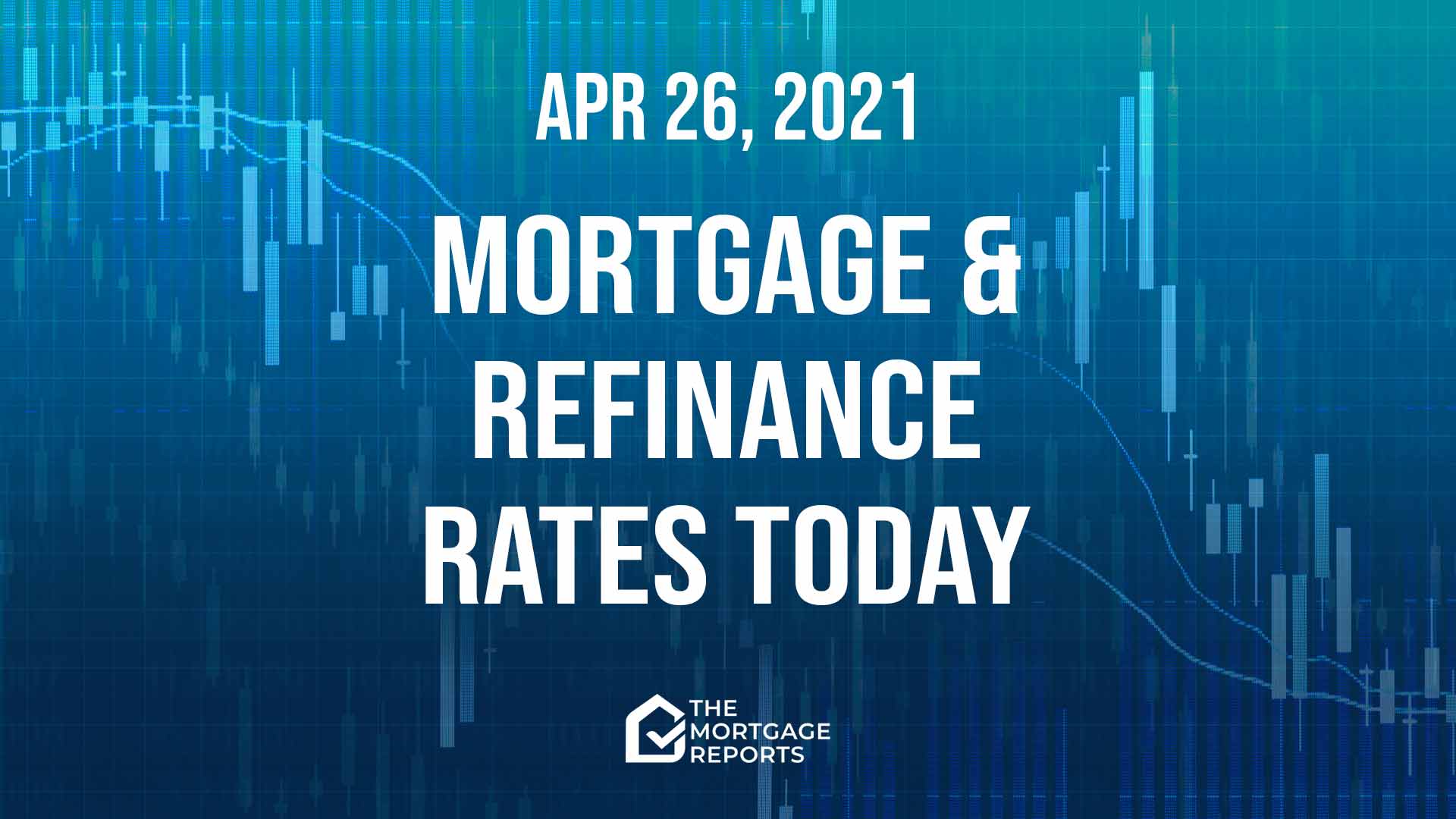
Today’s mortgage and refinance rates
Average mortgage rates edged a little lower last Friday. And that continued an April run that has so far seen only two rises this month.
Judging from early trading in key markets this morning, mortgage rates might rise modestly today. But we’ve made similar predictions in recent weeks only to see those markets change direction during the day.
Find and lock a low rate (Apr 27th, 2021)Current mortgage and refinance rates
| Program | Mortgage Rate | APR* | Change |
|---|---|---|---|
| Conventional 30 year fixed | |||
| Conventional 30 year fixed | 2.983% | 2.988% | Unchanged |
| Conventional 15 year fixed | |||
| Conventional 15 year fixed | 2.156% | 2.273% | Unchanged |
| Conventional 20 year fixed | |||
| Conventional 20 year fixed | 2.75% | 2.842% | Unchanged |
| Conventional 10 year fixed | |||
| Conventional 10 year fixed | 1.906% | 2.115% | +0.02% |
| 30 year fixed FHA | |||
| 30 year fixed FHA | 2.735% | 3.392% | Unchanged |
| 15 year fixed FHA | |||
| 15 year fixed FHA | 2.477% | 3.062% | Unchanged |
| 5 year ARM FHA | |||
| 5 year ARM FHA | 2.5% | 3.207% | Unchanged |
| 30 year fixed VA | |||
| 30 year fixed VA | 2.375% | 2.547% | Unchanged |
| 15 year fixed VA | |||
| 15 year fixed VA | 2.25% | 2.571% | Unchanged |
| 5 year ARM VA | |||
| 5 year ARM VA | 2.5% | 2.386% | Unchanged |
| Rates are provided by our partner network, and may not reflect the market. Your rate might be different. Click here for a personalized rate quote. See our rate assumptions here. | |||
COVID-19 mortgage updates: Mortgage lenders are changing rates and rules due to COVID-19. To see the latest on how coronavirus could impact your home loan, click here.
Should you lock a mortgage rate today?
All the rate lock recommendations below are set on lock. Let’s hope readers have been using their common sense and not following that advice while rates have been falling consistently.
But those who are still floating their rates should be prepared to act swiftly when (and I believe it is “when”) rates start to climb again. Because those rises could be sharp. Read on for more on what’s moving mortgage rates now.
And, for now, my personal rate lock recommendations remain:
- LOCK if closing in 7 days
- LOCK if closing in 15 days
- LOCK if closing in 30 days
- LOCK if closing in 45 days
- LOCK if closing in 60 days
But I don’t claim perfect foresight. And your personal analysis could turn out to be as good as mine — or better. So you might choose to be guided by your instincts and your personal tolerance for risk.
Market data affecting today’s mortgage rates
Here’s a snapshot of the state of play this morning at about 9:50 a.m. (ET). The data, compared with roughly the same time last Friday, were:
- The yield on 10-year Treasurys rose to 1.57% from 1.56% (Bad for mortgage rates.) More than any other market, mortgage rates normally tend to follow these particular Treasury bond yields, though less so recently
- Major stock indexes were mostly higher on opening. (Bad for mortgage rates.) When investors are buying shares they’re often selling bonds, which pushes prices of those down and increases yields and mortgage rates. The opposite happens when indexes are lower
- Oil prices fell to $61.35 from $61.60 a barrel. (Neutral for mortgage rates*.) Energy prices play a large role in creating inflation and also point to future economic activity.
- Gold prices edged lower to $1,777 from $1.786 an ounce. (Neutral for mortgage rates*.) In general, it’s better for rates when gold rises, and worse when gold falls. Gold tends to rise when investors worry about the economy. And worried investors tend to push rates lower
- CNN Business Fear & Greed index — Rose to 59 from 56 out of 100. (Bad for mortgage rates.) “Greedy” investors push bond prices down (and interest rates up) as they leave the bond market and move into stocks, while “fearful” investors do the opposite. So lower readings are better than higher ones
Caveats about markets and rates
Before the pandemic and the Federal Reserve’s interventions in the mortgage market, you could look at the above figures and make a pretty good guess about what would happen to mortgage rates that day. But that’s no longer the case. We still make daily calls. And are usually right. But our record for accuracy won’t achieve its former high levels until things settle down.
So use markets only as a rough guide. Because they have to be exceptionally strong or weak to rely on them. But, with that caveat, so far mortgage rates today look likely to rise modestly. Just be aware that intraday swings (when rates change direction during the day) are a common feature right now.
Find and lock a low rate (Apr 27th, 2021)
Important notes on today’s mortgage rates
Here are some things you need to know:
- Typically, mortgage rates go up when the economy’s doing well and down when it’s in trouble. But there are exceptions. Read ‘How mortgage rates are determined and why you should care
- Only “top-tier” borrowers (with stellar credit scores, big down payments and very healthy finances) get the ultralow mortgage rates you’ll see advertised
- Lenders vary. Yours may or may not follow the crowd when it comes to daily rate movements — though they all usually follow the wider trend over time
- When daily rate changes are small, some lenders will adjust closing costs and leave their rate cards the same
- Refinance rates are typically close to those for purchases. But some types of refinances are higher following a regulatory change
So there’s a lot going on here. And nobody can claim to know with certainty what’s going to happen to mortgage rates in coming hours, days, weeks, or months.
Are mortgage and refinance rates rising or falling?
Today and soon
The lead story on The Wall Street Journal’s website overnight ran under the headline, “West Looks Past Covid-19 and Sees Economic Resurgence.” And the article began:
After the worst year for the global economy since the Great Depression, the U.S. is set to lead a vigorous rebound in the West as mass vaccination against Covid-19 propels a return to more or less normal life.
— WSJ, April 25, 2021
This is a classic scenario in which mortgage rates should be rising. So why have they fallen so consistently so far this month?
Well, at the start of April, various technical reasons may have been behind the drops. But, more recently, it seems that fear of the COVID-19 pandemic’s economic impact on US trading partners may be playing the major role.
Currently, harrowing TV news footage of the tragedy unfurling in India illustrates this concern. And Japan has serious problems. But today’s New York Times shows falling infection and death rates in the US. Meanwhile, the rollout of the vaccination program here is gathering pace all the time.
So, perhaps, mortgage rates will only begin to rise again when investors switch their focus onto the excellent news at home and away from the pandemic’s global impact. When might that be? Nobody knows. But soon-ish seems a reasonable bet.
Unless, of course, something new causes the recovery here to be derailed. That’s always a possibility. But, to me, it doesn’t look probable.
For more background on my wider thinking, read our latest weekend edition, which is published every Saturday soon after 10 a.m. (ET).
Recently
Over much of 2020, the overall trend for mortgage rates was clearly downward. And a new, weekly all-time low was set on 16 occasions last year, according to Freddie Mac.
The most recent weekly record low occurred on Jan. 7, when it stood at 2.65% for 30-year fixed-rate mortgages. But then the trend reversed and rates rose.
However, those rises paused in April. And Freddie’s Apr. 22 report puts that weekly average at 2.97% (with 0.7 fees and points), down from the previous week’s 3.04%.
Expert mortgage rate forecasts
Looking further ahead, Fannie Mae, Freddie Mac and the Mortgage Bankers Association (MBA) each has a team of economists dedicated to monitoring and forecasting what will happen to the economy, the housing sector and mortgage rates.
And here are their current rates forecasts for the remaining quarters of 2021 (Q2/21, Q3/21, Q4/21) and the first quarter of 2022 (Q1/22).
The numbers in the table below are for 30-year, fixed-rate mortgages. Freddie’s were updated on April 14, Fannie’s on April 12 and the MBA’s on April 22.
| Forecaster | Q2/21 | Q3/21 | Q4/21 | Q1/22 |
| Fannie Mae | 3.2% | 3.3% | 3.4% | 3.5% |
| Freddie Mac | 3.2% | 3.3% | 3.4% | 3.5% |
| MBA | 3.4% | 3.6% | 3.7% | 3.9% |
However, given so many unknowables, the current crop of forecasts might be even more speculative than usual.
Find your lowest rate today
Some lenders have been spooked by the pandemic. And they’re restricting their offerings to just the most vanilla-flavored mortgages and refinances.
But others remain brave. And you can still probably find the cash-out refinance, investment mortgage or jumbo loan you want. You just have to shop around more widely.
But, of course, you should be comparison shopping widely, no matter what sort of mortgage you want. As federal regulator the Consumer Financial Protection Bureau says:
Verify your new rate (Apr 27th, 2021)Shopping around for your mortgage has the potential to lead to real savings. It may not sound like much, but saving even a quarter of a point in interest on your mortgage saves you thousands of dollars over the life of your loan.



